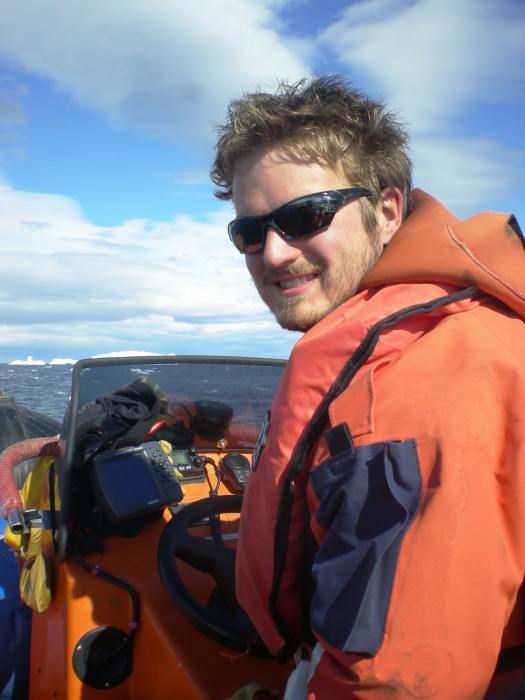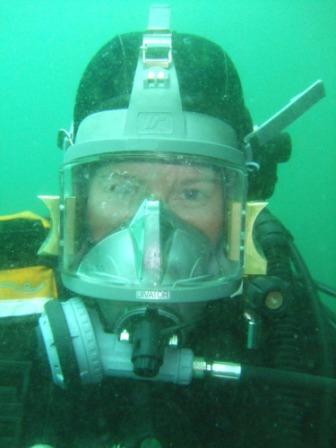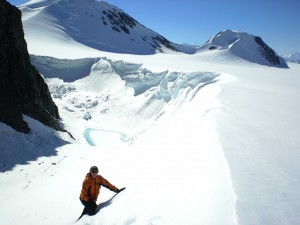Archive for February, 2010
JJ and work

JJ (John James) is our young (24 I think) year old Diving Officer. This is him being the dive cox for a dive off east beach. JJ is passionate about diving. He has done a multitude of course at the DDRC in Plymouth and keeps us all safe in the water. This is his second season down here having summered last year but this time he is going to be wintering.
Fossils at the Bluff
In Belemnite Valley just a mile and half along Promenade scree from the hut there are a multitude of Belemnites in the frost shattered rocks.
The fossils have also shattered so it is very hard to find a whole one and be able to get it out of the rock without damage. This one took a long time and I removed the rock around it by hand.
Back from the field
I am back at Rothera after a brilliant week out in the field at Fossil Bluff at 71 20S 68 17W. The Bluff as it is called is 222 miles north of Sky Blu and 226 miles south of Rothera. Only 585 miles from the south pole. The hut is on Alexander Island which is 145 miles wide in the south, 40 miles wide in the north and 275 miles long. The King George VI Sound which divides the island from the peninsula is 300 miles long and between 15 and 40 miles long it is an ice shelf more than 150 feet deep fed by glaciers coming in from the sides. The 24 hour sunlight in the summer melts the surface creating streams and lakes. The ice front is receding down the sound.
There is evidence on Alexander Island of continental drift – igneous, metamorphism, sedimentation, earthquakes, faulting, glaciation, and fossils showing profusion of life in the past showing climate change. 50 miles north and south of the hut is an area of sedimentary rock that was in shallow water with a large variety of flora and fauna. There are fossils of belemnites, ammonites, brachiopods, bivalves, plant remains, mould, coprolites, fossil dung, coal surrounded by trees and a variety of other plants. Submarine molluscs, aucellina, inoceramus, fish teeth and annelids have all been found here. The north and west of Alexander turns to volcanic with pyroclastic flows, dykes and major uplifting. Across the sound on the peninsula the rocks are plutonic with granite, azurite and other minerals having been found. The rocks are frost shattered creating scree slopes.
There are many lateral and medial morraines showing the ice sheets and glaciers are retreating. The hut is built on a lateral morraine where the fossil bluff glacier (one mile long) meets the sound. The scree covered slopes rise 1200 feet behind. The hut is 200 feet above sea level and 40-50 feet above the level of the sound. From the porch to the north you can see the Eros Glacier and Sucession Cliffs. To the East is the Antarctic Peninsula and the Batterbee Mountains over 7500 feet and 45 km away.
The first people to stay in the hut wintered arriving on March 4th 1962 after a 10 day build team had put the hut together. The hut is 20 feet long and 14 feet wide framed of iron girders, insulated prefabricated walls and a very heavy door. The main living area is 13 by 14 feet.
Dive Comms

We wear full face masks when diving and inside the mask is a little microphone. To talk you push the button on the front of the mask (see picture) On the outside left strap of the mask is a speaker which sits against your ear but on the outside of the hood. Amazingly you can actually hear through the 5mm hood. The only problems occur if you don’t get the mask on tight enough and the bubbles escape out the sides running past the speaker.
This is the box that sits in the boat while the divers are underwater. There is a transponder that hangs over the side of the boat. There is not normally that much conversation it really depends on the divers.
When a diver first goes in the supervisor tests the comms
– diver terri, diver terri topside comms check
– the diver responds – topside strength (scale between 1 and 5)
– supervisor responds – diver terri strength (scale between 1 and 5). This process is repeated for the second diver.
During the dive the supervisor might ask the divers for an air check or tell them to expect seals or to move in a direction away from and iceberg. Normally 10 minutes before the end of the dive the supervisor will tell the divers the minutes remaining before they need to be at safety stop of 6m. The divers will tell the supervisor when they are at
safety stop and when they are coming to the surface.
A week or so ago when I was supervising a dive MVT called on channel 18 to ask if we had divers in as there was Orcas off the wharf. Luckily our divers were at their safety stop at the end of a sucessful dive so I called down. ”Both divers please return to the surface as soon as possible.’ which when a supervisor says something along those lines we know means there is a lep or orca around.
The comms is not just used for safety although that is the primary purpose. It is very helpful for the science side of things and allows me to learn more from the marine scientists as I can ask what certain things are making the dive more interesting.
Melt pond

The picture is not of the pond at Fossil Bluff it is one of a very small glacier a few km from base.
There is a melt pond which is forming outside fossil bluff hut which sometimes gets so large that a boat is required to get from the ski way to the hut. Ponds of melted water can also develop under the ice. These ponds absorb the sun’s energy, rather than reflecting it as ice does, thereby having a significant influence on Earth’s radiation balance.
Adelie Penguins
Around Rothera we have a plethora of Adelie Penguins at the moment. At the beginning of the season they were a novelty however, now there are so many. They are one of the most common and well-known of all Antarctic penguin species. As one person put the other day it is hard to look at a penguin and not smile or laugh.
If you hang around long enough and make a call like theirs they will come right up to you and get within 2 feet or so of you. Apparently the meat is tough but tasty. However, I will not be eating on like my nephew suggested!
Weddell Seal
Weddell’s are the cutest seals at Rothera and stay around over the winter unlike the other seals which go out to sea. Their lifespan (20 years) is shorter as they use their teeth to ream out ice holes to breath through and their teeth wear out. Once a Weddell Seal’s teeth have worn down to a certain level, the seal is unable to eat and eventually starves to death.
Their pups are born in September. The Weddell Seal is known for its very deep dives, which may reach some 700 m (2,300 ft). It can also stay underwater for approximately 80 minutes.
Emperor Penguin
This is a lone Emperor Penguin that sat on a berg at the end of the runway for two days at Rothera. Emperor Penguins are rarely seen here maybe once or twice a year because there are no big colonies around here. They swim for miles and miles feeding but don’t necessarily stay together. The one that visited us is a juvenile which Danny the other boatman says you can tell by plummage so they aren’t drawn to the breeding colonies.
The first month I was in Antarctica I went out on a aerial photography flight as co pilot and took pictures of an Emperor Penguin colony on the east side of the peninsula from 2500 feet with my SLR. The pictures are being used by National Geographic – what is amazing is that you can see each individual penguin on my 10MB camera!
Emperor penguins are the largest of all the penguins. They stand almost 4 ft. (1.2 meters) tall and weigh 70 to 90 lbs. (30 to 40 kg.). They live and breed at the beginning of winter, on the fast ice all around the Antarctic continent. The total population is estimated to be about 200,000 breeding pairs. Emperor penguins can mate when they are 4 years old and can live to be 20 years of age.
Emperors live in the coldest climate on earth. Temperatures can drop as low as -140 degrees Fahrenheit (-60 degrees Celsius) on the Antarctic ice. After mating, the female lays one large egg. The egg is then immediately rolled to the top of the male’s feet. The egg is then incubated or kept warm on the male’s feet by a thick fold of skin that hangs from the belly of the male. The males manage to survive by standing huddled in groups for up to 9 weeks. During this time the female returns to the open sea to feed. During the time the male incubates the egg, he may lose about half his body weight because he does not eat.
The shape of their body helps them to survive. They have short wings that help them to dive up to 900 feet to catch larger fish. They can swim 10-15 kilometers an hour which lets them escape their main enemy, the leopard seal. They can stay warm because they have a thick layer of down under the outer feathers and a layer of blubber. The layer of downy feathers trap air that keeps the body heat in and cold air and water out. They also have large amounts of body oil that aids in keeping them dry in the water.
Catching Paraceradocus
Paraceradocus are basically little brown shrimpy things that live in algae and under rocks and grow to about 2cm in length living in shallows and at depth.
When Terri and I go diving for them she will lift the rocks and pick them up and I am right next to her with a tub with a lid and I open up the lid hopefully not letting out any of the contents and capture the little thing then quickly close the lid. It makes a difference if you work as a team as it is quicker than having to catch the little thing and then try to open the tub and get them in!
The shrimps are used in thermal limit experiments which means their respiration etc. is measured as they are warmed up. Basically their survival depends on how quickly they are warmed up but most perish at 2C increase in temperature so in the case of sea temperature rising by 2C they most likely would not survive.
Crane launching
The normal method of launching the RIBs is to use the ‘Noddy’ or Nodwell Crane off the wharf and then using the rope ladder to get down to the boat. The only problem we have is when we have a southerly or easterly which creates bad swell conditions at the wharf. Now and again we will also have a large iceberg in the way but with the current which swirls around Ryder Bay we can normally wait for a while and it has moved clear.

